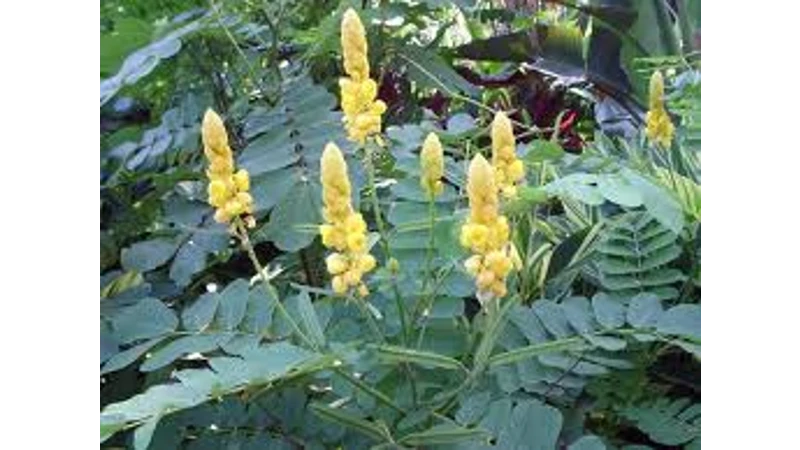Senna alata, commonly known as Candle Bush, Ringworm Bush, or Cassia alata, is a tropical medicinal plant recognized for its striking appearance and therapeutic properties. Native to Mexico and widely distributed across tropical regions, Senna alata is both valued for its ornamental beauty and its potent medicinal applications. This evergreen shrub, which can grow up to 4 meters tall, is famous for its bright yellow, candle-shaped flower clusters and large, lush leaves.
Senna alata is particularly known for its powerful antifungal properties, which make it a popular natural remedy for skin infections like ringworm and other fungal conditions. In addition, its rich antioxidant content has positioned it as a beneficial ingredient in modern skincare products, especially in sunscreens that protect against ultraviolet (UV) damage.
Botanical Characteristics of Senna Alata
Plant Structure
Senna alata is a shrub that typically grows between 3 to 4 meters tall. Its leaves are pinnately compound and range between 50 to 80 cm in length, each bearing multiple pairs of leaflets. The bright yellow flower clusters resemble candles, which is why the plant is often referred to as the Candle Bush. These clusters can bloom year-round in the right tropical conditions, adding vibrancy to gardens and landscapes.
Natural Habitat and Distribution
Though originally native to Mexico and Central America, Senna alata thrives in various tropical and subtropical regions around the world. The plant has adapted to a wide range of habitats, including wetlands, grasslands, and forest edges. However, in some regions, particularly in Southeast Asia and Africa, it is considered an invasive species due to its ability to spread rapidly.
Medicinal Uses of Senna Alata
Antifungal Properties
One of the primary traditional uses of Senna alata is in treating fungal infections. Its common name, Ringworm Bush, stems from its highly effective use against ringworm, a fungal infection of the skin. The plant’s leaves contain bioactive compounds, such as chrysophanic acid, which have been scientifically proven to have fungicidal properties. These compounds inhibit the growth of dermatophytes, fungi responsible for skin infections.
Antioxidant Benefits
In addition to its antifungal activity, Senna alata is rich in antioxidants, which are compounds that neutralize free radicals—unstable molecules that cause cellular damage and accelerate aging. Research has shown that extracts from the leaves of the plant can combat oxidative stress, reducing skin damage caused by UV radiation. This protective quality has led to its inclusion in various sunscreen formulations, where it provides synergistic benefits alongside other sun-blocking ingredients.
Other Traditional Medicinal Uses
Beyond its antifungal and antioxidant benefits, Senna alata has been used in traditional medicine to treat a range of conditions, including:
- Constipation: As with other species of Senna, its leaves contain anthraquinones, which have a natural laxative effect.
- Wound healing: Poultices made from its leaves have been applied to wounds to accelerate healing and prevent infection.
- Anti-inflammatory properties: The plant has been used to relieve inflammation and soothe skin conditions.
Modern Applications of Senna Alata in Skincare
The growing popularity of natural and herbal ingredients in skincare has increased the use of Senna alata in commercial formulations. Thanks to its antioxidant and antifungal properties, this plant plays a significant role in protecting the skin from environmental damage and infections.
Senna Alata in Sunscreens
Senna alata extract is found in several modern sunscreen formulations, particularly those designed for sensitive skin. One such product is Anthelios SPF 50+ Invisible Fluid Sunscreen and its tinted variant, both of which utilize Senna alata’s ability to fight free radical damage caused by UV exposure. Its combination with other active ingredients results in advanced, broad-spectrum protection against both UVA and UVB rays.
Suggested Products
These products offer non-comedogenic, water-resistant formulas enriched with Senna alata for enhanced skin defense, particularly for those prone to sunburn or UV-induced skin aging.
Ecological and Invasive Potential
While Senna alata offers numerous benefits, it also poses a challenge in some regions due to its invasive nature. Its ability to thrive in various environments and its rapid seed dispersal make it a potential threat to native plant species. Efforts are ongoing in some countries to manage its spread through invasive species control programs.
Conclusion
Senna alata is a plant of remarkable versatility, known both for its striking beauty and its potent medicinal benefits. From its historical use as a treatment for fungal infections to its modern role in skincare products, Senna alata continues to be an essential natural resource. Whether it’s protecting the skin from the harmful effects of UV rays or providing relief from fungal infections, this plant remains a powerful ally in promoting health and well-being.
Its antifungal, antioxidant, and laxative properties ensure its position as a valuable component in both traditional and contemporary medicine. As interest in natural remedies continues to grow, Senna alata stands out as a potent solution for skin health and environmental sustainability.
XXXXXXXXXXXXXXXXXXXXXXXXXXXXXXXXXXXXXXXXXXX
Senna alata (also known as Candle Bush or Cassia alata) is an important medicinal tree as well as an ornamental flowering plant.
Native to Mexico, Senna alata can be found in diverse habitats including the tropics. In certain parts of the world, it can become an invasive species. The shrub stands 3 to 4 meters tall and has leaves which are 50 to 80 cm long. Flowers grow in clusters appearing like a yellow candle (hence the name Candle Bush).
Senna alata is often called the Ringworm Bush because of it has very effective fungicidal properties, making it useful in the treatment of ringworm and other fungal infections of the skin. Additionally, the plant leaves are rich in antioxidants. Investigations have shown that a Senna alata extract can help to fight free radical damage associated with exposure to ultraviolet rays.
Senna alata can be found in a range of Anthelios sunscreens, where it works synergistically to deliver skin protection. Find it in:



